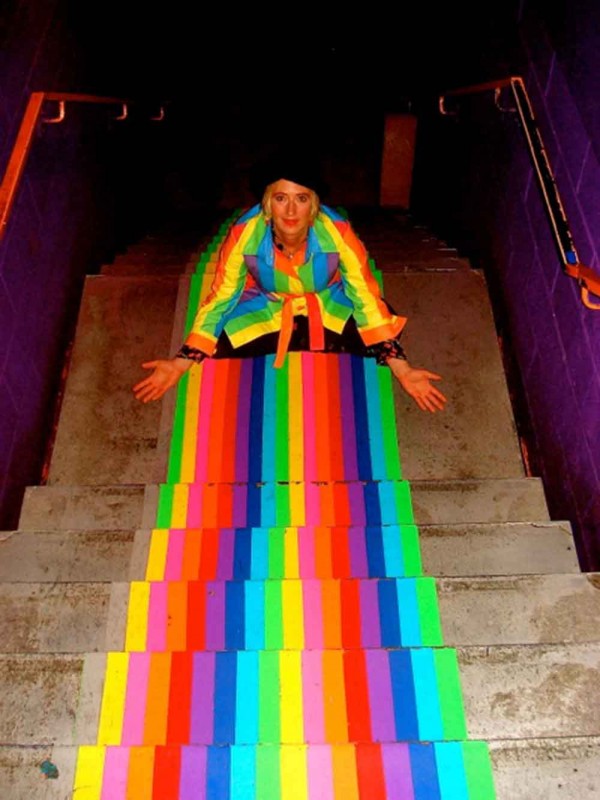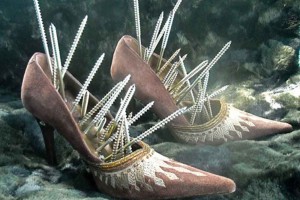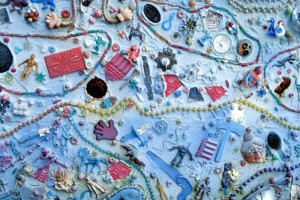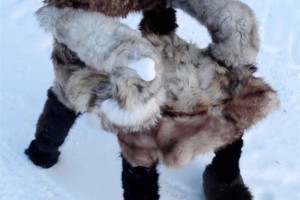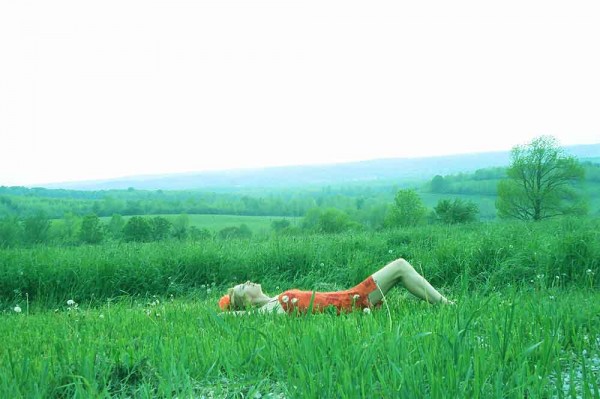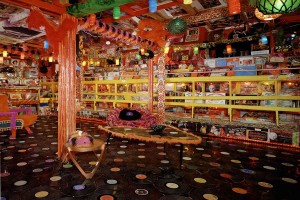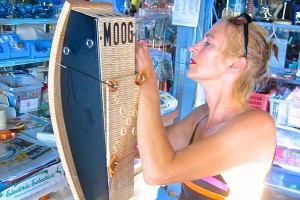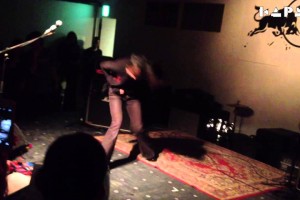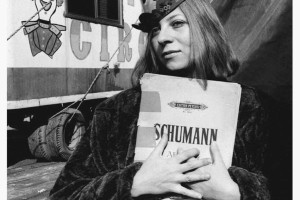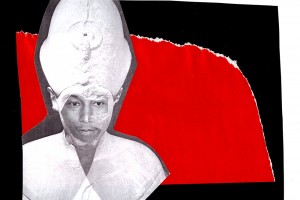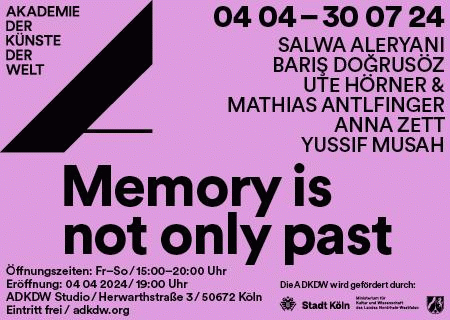Laura Kikauka: “Rediscovering the art of slowing down”
The first time I saw Laura Kikauka she was electrocuting a pickle. It was 1993 and Berlin was a playground for innovative experimentalists. The Canadian ex pat was one of their leaders. Laura creates spaces with collected objects. Like „The Glowing Pickle”, a space for people to hang out in-between DDR scientific and industrial equipment from local East Berlin dumpster containers. It was like a tightly packed laboratory filled with odd gadgets in which Laura flitted about, a beautiful apparition dressed in unusual outfits and showing people her “tie shredder machine” which would effectively shred ties or electrocute pickles by sticking two wires into an ordinary pickle and plugging it into 220 volts. The pickle would then burn and glow like a light bulb. I was impressed of course and became a fan of her work and of her incredible charm.
Laura Kikauka is almost impossible to describe because she seems most understandable when you experience her live, working on huge installations, wearing a bathing suit with fur boots or an evening dress with goggles, DJing exotic melodies from her enormous record collection of odd albums, making drinks for her friends or organizing a fashion show inside of her museum exhibition with the audience wearing objects of her exhibition, turning everything in the room into a surreal collection of fantasy creatures.
She is an installation artist and her work is a universe that glows like a star, making people happy, curious and excited. She collects things all the time and has hundreds of boxes stored in Berlin, NY and Toronto. Forgotten things like macramé owls or sausage tins. She makes lamps out of sausage glasses and totem poles out of teddy bears. She writes sad lyrics on second hand paintings with plastic letters from children’s learning kits and did a whole show of plastic skulls covered with cheap rhinestones, ironically echoing Daman Hirst’s million-dollar skull object. All of her objects are cheap and found or bought in second hand shops, markets, basements or thrift stores. She will travel miles for a good catch.
I suppose her art could be called a mixture of art trouvé and Dadaism but it goes much further, I would say it is a fantastically layered imagery of our many facetted world with all of its joy and pain, homes and toys loved but forgotten, the beauty and trash one meets daily, intermingling randomly, just as life does, creating the larger picture in the end that only few of us will ever understand and Laura is the demi-god bringing it all together.
After living in Berlin for almost two decades and installing her hundreds of objects not only in international museums and Galleries but also in theaters like the Volksbühne or event spaces like the legendary Schmalzwald or the Berliner “ White Trash” – places that would host long, long parties, she and Gordon left Berlin to go back to Canada where she started decorating her parents farm, turning it into the “Funny Farm” a magical, art universe. Besides doing a residency there in 2007, I go to visit regularly and often perform at Laura and Gordon’s music festival “Electric Eclectics” which they organize once a year, inviting a mixture of eccentric avant-garde sound artists, that perform amidst Laura’s installations, intermingling sound with color, shape with music and once more making the interactivity of life in all of its different shapes visible. The visitors come with their trailers or tents and stay for the weekend, visibly shaken and amazed at the world they were able to take part in for a couple of days. Laura is an exceptional figure, one of the non-stop artists that are not interested in social media or any kind of advertising. She works on her art pieces, followed by her fans and friends, exhibiting internationally and inviting friends to her art farm whenever they are in the vicinity. She is one of the most innovative, friendliest and inspiring personalities I have met worldwide. I am very happy to be able to present her here today.
Danielle de Picciotto: How would you define your art form?
Laura Kikauka: In general one could define it as MAXIMALISM (the opposite of minimalism) but I tend not to define ‘my art form’ in absolute terms. I work with mediums such as: text, sculptural objects, sound, painting modification, interior design, video, photography, performance, and dabble in ones yet to be discovered.
With some works/ concepts I have created immersive situations that viewers enter and things they encounter may seem familiar in some manner yet oddly juxtaposed or altered. This can even be in how they interact with the ‘vendor” as was the case with Schmaltzwald and Spätverkauf which was an art installation that imitated a store. This installation looked like a store in that it consisted of consumer products that were modified in some way. The fake store was also a parody on Germany‘s strict shopping laws at the time. For instance stores had to close at 6.30 pm Monday to Friday and 1 pm on Saturdays. But once a month there was something called ”Longer Saturdays” when they could stay open until 6 pm. At Spätverkauf we would have a party every Saturday featuring live shopping music with the motto ”Every Saturday is Longer Saturday”. In some installations and venues that I set up as a store, a visitor/viewer can purchase things but there is also something they cannot purchase which is this unique experience and interaction with the sales clerk.
These collaborations were each unique although Schmalzwald (1996-2000) and Wally Pott’s White Trash (2002-2017) were related because both were bars that were also hybrid art installations where performances took place in the midst of social interactions. The art installations stimulated the social interactions and vice versa, and the installations were constantly evolving over a long period of time (several years in both cases). There were also changes of venues for both bars, so they moved into new spaces in different neighborhoods and that changed the space and possibilities, of course. Aspects of these ideas course through almost everything I do or make, and ultimately I ended up living within one of them surrounded with creations, ideas and found objects in a place I call The Funny Farm – a never ending state of art in flux.
What do you look for in art?
LIFE! Something unusual & communicative not found in other mediums and preferable well endowed with humour.
What were your favorite exhibitions or events that you participated in? Could you shortly describe the exhibitions and why you especially liked them?
Tough question. But maybe these collaborative ones:
1) KBZ 200 (1990-94) which started as a collaboration between Gordon Monahan, Gordon W, and myself. It started as a joke: could we make a 90-minute cassette that featured different cover versions of three songs, without repeating any versions: Caravan, Taboo, and Quiet Village, using the existing vinyl record collection at the 2) Funny Farm in rural Ontario1990. We made cassette copies for our friends and everyone told us that they couldn’t stop listening to it and played it all day long on their auto repeat cassette machines. We were doing the same thing ourselves, so we decided to do an 18-hour performance playing only these three songs featuring live musicians and DJs. The 18-hour-duration was determined because that’s the approximate length of a performance of Erik Satie’s Vexations, which was the first conceptual piece to repeat the same music over and over again. Live shows featured many talented artists and musicians
3) Fuzzy Love (2000-2004, revived 2016-17). It was a band of three members: Gordon Monahan, Gordon W, and JJ Jones, established from Schmalzwald. My role in Fuzzy Love was that I was the DJ who performed between their sets, and mostly did their set deco & embellishments. .
4) “Schmalzwald” (see above) I liked these four collaborations because of being outside of a gallery context and being with creative people, there were a lot of spontaneous actions one could not be scripted. It was a lot of fun/ funny and quite bright with intelligence and foolery combined.
What are you working on momentarily?
WORK? My work is PLAY. At the moment I am playing around with new tropical materials.
Could you describe why and what you like about exotic materials as exotica is something that pops up quite often in your work and surrounding?
Oh yes, exotica, not to be defined by Tiki alone. In this case I am referring to tropical materials available on the beach and jungle (for free) where we spend time in the Dominican Republic. Crazy palm growths, bamboo, wild vegetation, shells all sorted which I sort categories, for example: tiny favorites, brain coral, hard toe nails, vaginal, tiny pink wonders, purple triangles, coral cheeses, caramel spirals, baby & mama conch, petrified golf balls, weird wood, things with holes in it… etc. I think it’s like any artist who travels to a new culture and you see creative applications for materials, which are new to you.
Any plans for the future?
I take it by the moment, by the day. No plans. Even though the future is sooner than we think.
You are always working on so many things non-stop it is hard to keep up. Thanx. It always seems to be a mixture of things, between computer endeavors: filing quotes/ titles/ creating new word play/correspondence/entertainment/research, trying musical experiments, video /recordings, joking around with hockey pen pals, and more… In other mediums: making lamps, sculptural objects, costumes, mosaics, etc. Most lately rediscovering the art of slowing down! Been trying to tame my obsessiveness and being able to relax and just dream a little more. George Carlin says: “There’s no present. There’s only the immediate future and the recent past.”







